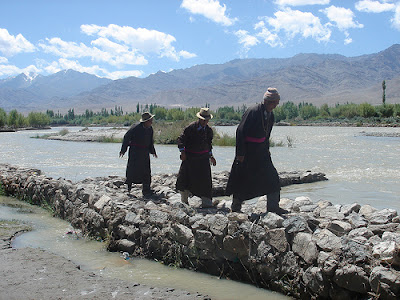Leh, Ladakh
Just when I am getting used to the consistent inconsistency of India,
 someone starts getting reliable and timely on me. Yesterday, I got a surprisingly prompt email reply from the Delhi Bureau of HH the Dalai Lama.
someone starts getting reliable and timely on me. Yesterday, I got a surprisingly prompt email reply from the Delhi Bureau of HH the Dalai Lama. Dear _____
Today I have inquired about your PAP (Protected Area Permit) case to the dealing officer Mr.T___ C____. He replied me verbally that in mid of December 07 possible to get PAP sanction. In this way, you remind me on mid december. If your PAP permit release then you need not come to Delhi for the collection. Because I can send it by the mail attachment copy to your mail address. Obviously, you can also come and collect it.
Thanks
T____
--OBviously!
So, it looks like I may not have to hoof it out to the Delhi Bureau at all. I can just email "Mr. T. "sometime around 2nd week of December, and ostensibly, he will be reminded to email me the Protected Area Permit for Mundgod, Karnataka.
A stop through Delhi may be mandatory anyway, as it is the usual air transit point between Ladakh and anywhere. (An alternate route would be to fly to Jammu, on the other side of J&K state, then take a bus - about 8 hours ride - to Dharamsala.) The jeeps, both to Manali and Srinagar, will stop running any day now (so they say) due to snow on the high passes. It's hard to remember this, as days here in the valley are still warm and sunny. So, the only way out will be via air. Indian Airlines, Jet Airways and Air Deccan/Kingfisher all fly between Leh and Delhi. (Air Deccan and Kingfisher had a merger a few months ago. They seem to have compromised by keeping the name Air Deccan but adopting the red Kingfisher logo. Air India and Indian Airlines have also merged recently, into one Indian Airlines.)
Air Deccan is the cheapest at 3,022 Rs (about $75) for a one-way flight. Jet Air and Indian Airlines are both around 4,600Rs for the same flight.
Rocks and a hard place
Some people disparage "hanging out with other tourists" when they travel. The fellow travelers in Ladakh, however, have proven to be worth
 knowing. They have given me some great memories of my three months in Ladakh: JonJost, Emil, Flora and Karin from Netherlands; John and Jamie from UK; Yasmine from Belgium; Enrico from Italy; Takasi and his friends from Japan; Teodora and Misha from Russia via Canada; Voytek from Poland; the nice guy from Slovenia who helped me fix my laptop - the list goes on. You never know who you're going to meet at dinner. Most Ladakh travelers are more adventurous, outdoorsy and interested in engaging directly with the culture than your average backpacking-partygoer.
knowing. They have given me some great memories of my three months in Ladakh: JonJost, Emil, Flora and Karin from Netherlands; John and Jamie from UK; Yasmine from Belgium; Enrico from Italy; Takasi and his friends from Japan; Teodora and Misha from Russia via Canada; Voytek from Poland; the nice guy from Slovenia who helped me fix my laptop - the list goes on. You never know who you're going to meet at dinner. Most Ladakh travelers are more adventurous, outdoorsy and interested in engaging directly with the culture than your average backpacking-partygoer.Martin, a Swiss man at my guest house (staying along with his wife and two small girls) turned out to be an archaeologist and expert on the prehistoric rock art of Ladakh. Iron Age and Bronze Age rock art - featuring hunting scenes, shamanic dances and herds of primitive animals like the buffalo and ibex - is found all over Ladakh. It's very rarely mentioned in any tourist guide or trip itinerary, and its existence is only barely acknowledged by the government. Occasionally a metal sign-board is erected proclaiming the carved boulders as "protected monuments" and threatening fines for their defacement; that's about the extent of government protection.
Ironically, the government itself seems primarily to blame for the destruction of the ancient art. Martin says the giant boulders are being broken, blown up with dynamite and crushed into rubble for use in the new expanding roads of Ladakh, particularly the one under construction from Chiling to remote Zanskar.
Martin, who has been frequenting Ladakh for 15 years and speaks Ladakhi language, has been studying and documenting this rock art almost nonstop for the past 10 years. He's in a bit of a hurry - every year he returns, more of the boulders and their carvings have vanished. He published one study, all in French (but I can make out a great deal of it).
Martin doesn't seem to hold much hope for the protection of this archaic art. For one thing, it's not centralized in such a way that it could be easily protected and monitored; the carvings are strewn over most of the Ladakh Indus Valley and Zanskar. Nor could awareness be raised by promoting easy public tours of the sites - most of them are too scattered and many of the interesting ones are far from the roads.
But more than logistical challenges, the government, including the designated authorities such as Archaeological Survey of India, just do not seem to care. Perhaps it's too much to ask the military road-building bodies such as Border Roads Organization to recognize the importance of these things. But there are plenty of antiquities and archaeology entities in India that should be on the job. Such offices are notoriously proprietary when it comes time to issue research visas and permits to foreigners to study such things. Where are they when the works of art are being destroyed?
In fact, Martin says they are so lackadaisical about these ancient rock carvings, he has not even been required to work on an official research visa. He just comes on a regular tourist visa. It's all he can do to "get arrested," as they say, regarding his work.
Martin thinks it's mostly the location. The powers that be, comfortable in their Delhi offices, are just not interested in trekking out to remote, dusty steppes in the desert to check out what's going on, he says. On the odd occasion when attention is drawn to the area, a perfunctory sign is erected, the official self-congratulatory photos are snapped in front of it, and the govt. officials fly back to Delhi having had a nice weekend in Ladakh.
The road workers themselves are more often than not illiterate migrant workers from impoverished places like Nepal and Bihar, who can't be expected to recognize or preserve the carvings. As for the local villagers, about 70% of Ladakhis still live a traditional lifestyle, meaning subsistence village agriculture and animal husbandry. They certainly don't have the time or even ability to agitate for protection of a bunch of rocks.
I was able to view some of the archaic art on my trip to Dha-Hanu in Kargil district. These carvings are far more than crude stick figures. Some are fluid, with swirly motion reminiscent of Celtic designs. Others feature surreal, shamanic details, like an ordinary figure with giant outsized hands upraised, or figures wearing curious headdresses. Despite the sign "protecting" the rocks, some thoughtful locals had added their very own contributions. Alongside the Iron Age artwork, someone had carved (in English letters) his name and occupation, "Hassan Mechanic."
Having heard the archaeologist's side of the story, I decided to get quotes or statements from the local Antiquities Registration Board, and the Archaeological Survey of India (ASI) office. So far, every trip (three) to the Antiquities office (which looks like an antiquity itself) has found Nobody Home. Any day, any time I go there, no one is there. What a great job!
I bet they are out on location at some remote site registering artifacts....right.
There's always some old Ladakhi men there, with their ruddy cheeks and maroon coloured goncha robes, sitting in front of the empty office. "Close," one of them says with a big smile showing missing teeth. His smile gets bigger every day I return.
I will try again on Monday, but I'm not holding my breath.














1 comment:
Guys,
*Check out http://www.learnsalsa.com
For Salsa Lessons in Los Angeles,Salsa Classes and Videos,Private salsa lessons,Salsa DVD's,Salsa Bootcamps
Post a Comment